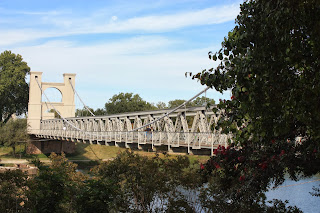"Lone Star Historian 2" is a blog about the travels and activities of the State Historian of Texas during his second year. Bill O'Neal was appointed to a two-year term by Gov. Rick Perry on August 22, 2012, at an impressive ceremony in the State Capitol. Bill is headquartered at Panola College (www.panola.edu) in Carthage, where he has taught since 1970. For more than 20 years Bill conducted the state's first Traveling Texas History class, a three-hour credit course which featured a 2,100-mile itinerary. In 2000 he was awarded a Piper Professorship, and in 2012 he received the Lifetime Achievement Award from the Wild West Historical Association. Bill has published over 40 books, almost half about Texas history subjects, and in 2007 he was named Best Living Non-Fiction Writer by True West Magazine. In 2013 he was awarded an honorary Doctor of Letters degree by his alma mater, Texas A&M University - Commerce.
 The East Texas Historical Association staged its Fall Meeting at the Fredonia Hotel in Nacogdoches on Thursday, Friday, and Saturday, September 26-27-28. More than 230 ETHA members gathered to enjoy an excellent slate of programs and the company of fellow historians and old friends. It was the second largest attendance in the 51-year history of the ETHA.
The East Texas Historical Association staged its Fall Meeting at the Fredonia Hotel in Nacogdoches on Thursday, Friday, and Saturday, September 26-27-28. More than 230 ETHA members gathered to enjoy an excellent slate of programs and the company of fellow historians and old friends. It was the second largest attendance in the 51-year history of the ETHA.
 |
Exhibitors Hall, with Ron Chrisman on duty
the UNT Press table. |
There were 22 sessions, most of which featured three presentations. The sessions on "Black Women and Their Scholarship" and on "Texas Labor History" each offered four presentations There was a panel on "Twentieth Century Texas Rangers," and another on "The Kennedy Assassination: A Fifty Year Perspective " The ETHA sponsored a joint session with the Texas Folklore Society, and two with the West Texas Historical Association.
 |
| ETHA Secretary-Treasurer Chris Gill |
 |
| Linda Hudson and her entertaining presentation |
On Thursday evening, the Max and Georgianna Lale Lecture Series presented Quintard Taylor of the University of Washington. At the Friday luncheon, the crowd was spellbound by Heino Erichsen's address, "The Reluctant Warrior: A POW Remembers." Drafted into Hitler's army as a teenager, he came to the United States as a prisoner of war, and several years after World War II he returned to the U.S. and attained citizenship. Dr. Bruce Glasrud delivered his presidential address, "Anti-Black Violence in 20th Century East Texas " at the Friday evening Banquet. There was a Women's History Breakfast on Saturday morning, followed by a Women's History Session with two delightful programs: "Hogs Gone Wild in the Texas Supreme Court" by Linda S. Hudson, and "The Great Tyler Chicken War of 1914" by Vickie Betts.
 |
Lynn Burlbaw and his student/presenters,
Mychelle Smith and Stephen Scogin |
A number of graduate students from several institutions offered informative
presentations. An especially fascinating session was organized by Dr. Lynn Burlbaw of Texas A&M University. In his graduate course, "History of Education," Dr. Burlbaw requires his students to prepare and present a "Biography of an Old School." The structure must be at least 50 years old, and the assignment features the presentation of 20 images of the old school with a commentary lasting no more than 20 seconds per image. Dr. Burlbaw's two presenters were Mychelle Smith and Stephen Scogin, experienced public school educators who are working on doctorates in the field of education. Neither is a history major. Dr. Burlbaw rarely has history majors in his program, and most of his students approach this assignment with doubts. But as they go through old annuals and interview former students, the venerable schools come back to life.
 |
| Bill presenting for the WTHA |
Certainly that was the case for Mychelle Smith (Palestine's stately 1915 high school, which now houses the Museum for East Texas Culture) and Stephen Scogin (the now-abandoned Gaston High School and its surrounding complex of buildings). I have visited these old schools on numerous occasions and I was captivated by both presentations. Mychelle and Stephen were highly knowledgeable about their assigned buildings and had become involved with the one-time schools and teachers and students and communities. I have long contended that historical architecture is our most tangible reminder of the past, and this assignment confirms this contention. Dr. Burlbaw and his students are to be complimented on their historical exercise - an exercise that could be richly utilized in a variety of history courses.
 |
| Pat Parsons, foreground, presided over this WTHA session. |
 |
L to R: Patrick Hughes, Pres. Bruce Glasrud,
Dan Utley at the Friday evening reception |
The Fall Meeting closed with the Awards Luncheon. Dr. Kenneth Hendrickson of Midwestern University was named Educator of the Year. There was a tie for Book of the Year: Kate Kirkland's superb biography of Captain James A. Baker of Houston, 1857-1941. published by Texas A&M Press; and Just Between Us, Stories and Memories from the Texas Pines, edited by Dan Utley and Milton Jordan, and published by Stephen F. Austin University Press. Other awards included research grants from the Ottis Lock Foundation. The Fall Meeting ended when Bruce Glasrud handed the president's gavel to Gene Preuss, who announced that the Spring Meeting would be held in Emory, February 20-22, 2014.
 |
Presenting Ken Hendrickson the
Educator of the Year Award. |
 |
Editors Dan Utley and Milton Jordan (rear) with several
contributors to award-winning Just Between Us |
 |
Bruce Glasrud hands the president's gavel
to Gene Preuss. |




























































